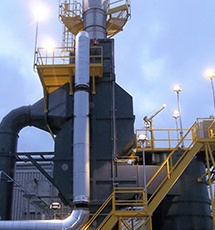Catalytic Products International (CPI) installed a Regenerative Thermal Oxidizer (RTO) at an Eastern USA membrane coating operation for the abatement of Volatile Organic Compounds (VOCs).

In this application the customer required air pollution control equipment to comply with existing permit limits, allow for production at full capacity and accommodate future expansion. CPI worked closely with the customer to design a system providing both high destruction rate efficiency (DRE) and high thermal efficiency.
The 2,000 SCFM Triton II-Series Regenerative Thermal Oxidizer will control VOC emissions- including cyclohexane and isopropyl alcohol from five (5) coaters in the manufacturing process. To provide +99% destruction rate efficiency (DRE) of the VOCs, CPI equipped the RTO with an auxiliary VOC Polishing Chamber system. While the process emissions contain low concentrations of VOCs and provide little heat release, CPI was able to raise the thermal efficiency to 97% with a special media design. This upgrade reduced overall fuel consumption and CO2 emissions.
Thermal treatment of VOCs and other air pollutants works by a simple reaction with oxygen at high temperatures. In this environment, the VOCs are chemically oxidized to form harmless inert by-products (CO2, water vapor) and usable heat.
CPI Regenerative Thermal Oxidizers (RTOs) are engineered to provide exceptional performance and reliability. During operation of the standard two-chamber RTO, the VOCs are directed into one of the system’s regenerators: an internally insulated vessel containing specialized ceramic media which allows thermal rate efficiencies up to 97%. The contaminated gases are passed through the first regenerator where energy is transferred from the ceramic media to the gas in order to elevate the temperature. This elevated temperature approaches the ignition level for most solvents and is then directed from the ceramic bed into the combustion chamber. As the stream exits the ceramic bed and travels through the internally lined combustion chamber, minimal heat is added to ensure a proper oxidation temperature and a designed dwell time is maintained providing destruction of the VOCS at greater than 98% efficiency. The clean, oxidized gases are directed to the second regenerator to absorb the heat energy before being released to the atmosphere. As the ceramic media loads with sufficient heat, the Posi-Seal Valves switch, and the gases are reversed through the system where the heating and oxidation process continues.
For the spilt second that it takes for the valve switch to occur, a "puff" of untreated gases is released to atmosphere. This small concentration of VOC lowers the removal efficiency in standard two-regenerator systems. The addition of a specialized VOC Polishing Chamber system between the RTO and the exhaust stack allows recirculation of the “puff” of untreated gases to the RTO inlet, achieving +99% VOC destruction rate efficiency.
CPI delivered a fully skid mounted, pre-piped and pre-wired RTO with the media installed on a customer supplied concrete pad. The location of the RTO was limited due to space constraints around the exterior of the building. The installation of the RTO and related equipment included fresh air purge and isolation dampers, flame arrestor, booster fan and exhaust stack. CPI provided on-site supervision to minimize the downtime associated with the installation of the RTO. This approach ensured that entire system was installed correctly, and the facility was back up and producing product with minimal downtime.
CPI has been “Enabling Clean Production Since 1969” and continues as a leading supplier of air pollution control equipment. CPI is at the forefront in providing industries including web coating facilities with solutions to their air pollution control needs.
Today, CPI partners with its customers as a trusted resource in resolving the most complex air pollution and energy conservation problems. We provide our customers with innovative and cost-conscious solutions to their most complex VOC, NOx, and Odor pollution challenges. Our equipment is also at work meeting energy conservation strategies and minimizing greenhouse gas (GHG) emissions.








